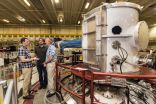(Press-News.org) DURHAM, N.C. -- Racially and economically mixed cities are more likely to stay integrated if the density of households stays low, finds a new analysis of a now-famous model of segregation.
By simulating the movement of families between neighborhoods in a virtual "city," Duke University mathematician Rick Durrett and graduate student Yuan Zhang find that cities are more likely to become segregated along racial, ethnic or other lines when the proportion of occupied sites rises above a certain critical threshold -- as low as 25 percent, regardless of the identity of the people moving in.
Their results appear online in Proceedings of the National Academy of Sciences and will be published in a forthcoming issue.
Efforts to understand residential segregation using mathematical models are not new. More than 40 years ago, Nobel Prize-winning economist Thomas Schelling devised a now-famous model of segregation in which families, living on a 2-D grid, make choices about where to live based on the characteristics of their neighbors.
In Schelling's original model, using checkers and dice, a simple artificial city consists of two groups of equal size, each of which prefers to live with a certain minimum proportion of neighbors like them.
Schelling showed that even people who are happy living in mixed neighborhoods, and only seek to avoid living in neighborhoods where they are in the minority, eventually reach a "tipping point" and move -– largely because the movement of other people from one neighborhood to the next changes the makeup in both locations in a way that initiates a chain reaction.
Schelling's finding -- that even slight preferences can promote segregation -- may help explain why residential segregation persists in American cities despite years of policies and programs to counteract it.
Using sophisticated computer simulation to replace Schelling's physical model, Durrett and Zhang modeled the behavior of two kinds of families, designated as blue and red, as they moved from one part of a city to the next in search of a neighborhood they consider "acceptable."
In their computer model, every family seeks to live somewhere where families of the other color make up no more than a given percentage of the neighborhood.
Their movements are governed by a simple rule: families that are happy with the makeup of their current neighborhood tend to stay put, while "unhappy" families are more likely to move. When a family decides to move, they can relocate to a vacant site in any neighborhood in the city.
By analyzing the model, the Duke researchers showed that reds and blues can happily coexist indefinitely as long as the density of occupied sites in each neighborhood remains low.
However, as soon as the density of households in a neighborhood exceeds a certain threshold -– in this case 25 percent of the available sites, regardless of color –- the city quickly becomes segregated. Before long, the reds start to cluster in red neighborhoods and the blues in blues, until eventually the majority of families live in neighborhoods where almost all of their neighbors look like them.
Their results successfully confirm one of Schelling's main results -- that cities can become segregated in a short amount of time.
The authors don't offer any explanations for why a real-life city might become segregated as it starts to fill in, but other researchers suggest this could be because higher-density neighborhoods tend to consist of a single type of housing.
The current version of their model assumes that reds and blues are in equal numbers, and every household has the same degree of intolerance, but in real-life cities everyone is different.
Applying their model to real cities, the authors say, would require analyzing a version that allows the proportion of reds and blues and their degree of intolerance to differ –- as is the case when one group prefers to be with their own color, and the other group is happy either way.
While their model is simple, it adds to a body of research aimed at understanding how neighborhoods might change in response to different factors thought to promote or maintain integration, and why some cities are more or less segregated than others.
INFORMATION:
This work was supported by the grants from the Probability Program at the National Science Foundation.
CITATION: "Exact solution for a metapopulation version of Schelling's model," Durrett, R. and Zhang, Y. Proceedings of the National Academy of Sciences, 2014. http://www.pnas.org/content/early/2014/09/11/1414915111
Could suburban sprawl be good for segregation?
Low-density neighborhoods more likely to stay integrated
2014-09-23
ELSE PRESS RELEASES FROM THIS DATE:
Safe passages into adulthood: Preventing gender-based violence and its consequences
2014-09-23
WASHINGTON, DC -- Gender-based violence affects the physical and mental health of girls and boys, men and women worldwide. A recent study by researchers from the Institute for Reproductive Health at Georgetown University addresses the challenge of developing effective strategies to change inequitable and harmful social norms that result in gender-based violence.
Inequitable gender norms are not only related to domestic violence, but also to other behaviors such as multiple sexual partners, smoking and alcohol abuse which lead to poor health outcomes.
The findings ...
A piece of work demonstrates various ways for controlling light in the terahertz frequency
2014-09-23
This news release is available in Spanish.
The Journal of Optics has devoted the front page of its special edition on Mid-infrared and THz Photonics to the work produced by the NUP/UPNA-Public University of Navarre researchers Víctor Pacheco-Peña, Víctor Torres, Miguel Beruete and Miguel Navarro-Cía (former student currently working at Imperial College London), together with Nader Engheta (University of Pennsylvania), one of the world's leading experts in metamaterials. In their research they have proposed various devices capable of redirecting electromagnetic waves ...
New hope for beloved family pets
2014-09-23
Nearly one out of four dogs will develop cancer in their lifetime and 20 per cent of those will be lymphoma cases.
A team of researchers from the University of Leicester has helped Avacta Animal Health Ltd to develop a new user-friendly electronic system for diagnosing lymphoma in dogs in the early stages, and for remission monitoring.
Marketed as cLBT (canine lymphoma blood test), this is the first test of its kind to track the remission monitoring status of a dog after undergoing chemotherapy.
Led by Professor Alexander Gorban from the University's Department ...
Kinsey study of single parents' dating, sexual activity contradicts assumptions
2014-09-23
BLOOMINGTON, Ind. -- Contrary to what is often assumed about single parents, particularly single parents of young children, a new study from The Kinsey Institute has found that single parents of children younger than 5 date and are sexually active as often as singles without children -- and more so than single parents of older children.
The study, "Dating and Sexual Behavior Among Single Parents of Young Children in the United States," was published online in the Journal of Sex Research prior to appearing in print. Co-authors are lead author Peter B. Gray, University ...
Smart meters could cause conflict for housemates, study shows
2014-09-23
Arguments about whose turn it is to do the washing up, negotiating rights to the TV remote control and disputes over noise — as many students returning to university for the new academic year are about to learn the hard way, sharing a house can be a tricky business.
And now research from academics at The University of Nottingham has revealed that new technology to allow people to monitor their energy usage in the home could be about to ratchet up the tension.
The study by a team of technology experts and psychologists found that meters which allowed residents to look ...
EORTC presentations at ESMO 2014 Congress
2014-09-23
EORTC investigators will present the results of their cancer research at ESMO 2014 Congress, 26-30 September 2014 in Madrid.
Joint Symposium: ESMO-ASCO: The Evolution of the clinical trial landscape
Monday, September 29, 11:00 AM - 12:30 PM, Room: Granada
Abstract 121IN: Denis Lacombe. Can Collaborative Molecular Screening Platforms support new forms of cancer clinical research? The example of the EORTC SPECTA program.
Proffered Paper session: Melanoma and other skin tumors
Saturday, September 27, 2:00 PM - 3:45 PM, Room: Barcelona
Eggermont AM, Chiarion-Sileni ...
Opportunities to reduce patient burden associated with breast cancer screening
2014-09-23
New Rochelle, NY, September 23, 2014—New technology and better screening strategies can lower the rate of false-positive results, which impose a substantial financial and psychological burden on women. The many misperceptions about breast cancer screening options and risks, the benefits and costs of screening, and the need for new approaches and better education are discussed in a series of articles in a supplement to Journal of Women's Health, a peer-reviewed publication from Mary Ann Liebert, Inc., publishers. The supplement is available free on the Journal of Women's ...
2014 Arctic sea ice minimum sixth lowest on record
2014-09-23
Arctic sea ice coverage continued its below-average trend this year as the ice declined to its annual minimum on Sept. 17, according to the NASA-supported National Snow and Ice Data Center (NSIDC) at the University of Colorado, Boulder.
Over the 2014 summer, Arctic sea ice melted back from its maximum extent reached in March to a coverage area of 1.94 million square miles (5.02 million square kilometers), according to analysis from NASA and NSIDC scientists. This year's minimum extent is similar to last year's and below the 1981-2010 average of 2.40 million square miles ...
Actions on climate change bring better health, study says
2014-09-23
MADISON, Wis. — The number of extremely hot days in Eastern and Midwestern U.S. cities is projected to triple by mid-century, according to a new study led by University of Wisconsin-Madison researchers and published today in the Journal of the American Medical Association.
Milwaukee and New York City could experience three times as many 90-degree days by 2046; Dallas could see twice as many days topping 100 degrees. The new analysis offers climate data through the lens of public health, in a study that represents a synthesis of the latest science at the intersection of ...
Sandia magnetized fusion technique produces significant results
2014-09-23
ALBUQUERQUE, N.M. — Researchers at Sandia National Laboratories' Z machine have produced a significant output of fusion neutrons, using a method fully functioning for only little more than a year.
The experimental work is described in a paper to be published in the Sept. 24 Physical Review Letters online. A theoretical PRL paper to be published on the same date helps explain why the experimental method worked. The combined work demonstrates the viability of the novel approach.
"We are committed to shaking this [fusion] tree until either we get some good apples or a ...
LAST 30 PRESS RELEASES:
Autistic and non-autistic faces may “speak a different language” when expressing emotion
No clear evidence that cannabis-based medicines relieve chronic nerve pain
Pioneering second-order nonlinear vibrational nanoscopy for interfacial molecular systems beyond the diffraction limit
Bottleneck in hydrogen distribution jeopardises billions in clean energy
Lung cancer death rates among women in Europe are finally levelling off
Scientists trace microplastics in fertilizer from fields to the beach
The Lancet Obstetrics, Gynecology, & Women’s Health: Taking paracetamol during pregnancy does not increase risk of autism, ADHD or intellectual disabilities, confirms new gold-standard evidence review
Taking paracetamol during pregnancy does not increase risk of autism, ADHD or intellectual disabilities
Harm reduction vending machines in New York State expand access to overdose treatment and drug test strips, UB studies confirm
University of Phoenix releases white paper on Credit for Prior Learning as a catalyst for internal mobility and retention
Canada losing track of salmon health as climate and industrial threats mount
Molecular sieve-confined Pt-FeOx catalysts achieve highly efficient reversible hydrogen cycle of methylcyclohexane-toluene
Investment in farm productivity tools key to reducing greenhouse gas
New review highlights electrochemical pathways to recover uranium from wastewater and seawater
Hidden pollutants in shale gas development raise environmental concerns, new review finds
Discarded cigarette butts transformed into high performance energy storage materials
Researchers highlight role of alternative RNA splicing in schizophrenia
NTU Singapore scientists find new way to disarm antibiotic-resistant bacteria and restore healing in chronic wounds
Research suggests nationwide racial bias in media reporting on gun violence
Revealing the cell’s nanocourier at work
Health impacts of nursing home staffing
Public views about opioid overdose and people with opioid use disorder
Age-related changes in sperm DNA may play a role in autism risk
Ambitious model fails to explain near-death experiences, experts say
Multifaceted effects of inward foreign direct investment on new venture creation
Exploring mutations that spontaneously switch on a key brain cell receptor
Two-step genome editing enables the creation of full-length humanized mouse models
Pusan National University researchers develop light-activated tissue adhesive patch for rapid, watertight neurosurgical sealing
Study finds so-called super agers tend to have at least two key genetic advantages
Brain stimulation device cleared for ADHD in the US is overall safe but ineffective
[Press-News.org] Could suburban sprawl be good for segregation?Low-density neighborhoods more likely to stay integrated






